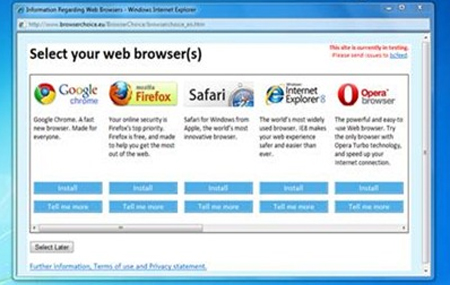Six of the twelve developers featured on Microsoft's Windows browser choice screen have complained to the EU, insisting that Microsoft's current design doesn't meet its intended goal.
The browser choice screen, introduced earlier this month and expected to feature on nearly 200 million European Windows computers by the end of April, was introduced following anti-competitive complaints from rival browser providers, and is designed to provide consumers with a greater choice of software solutions.
However, despite meeting the approval of the European Commission, many of Microsoft's rivals now claim the current browser choice screen design leaves "the vast majority of users unaware that there are more than five browsers to choose from".

Microsoft's browser choice screen, pictured above, lists five "first tier" browsers in a randomised order, with a further seven random browsers viewable by scrolling to the right.
Six of the seven featured outside of the initial viewing area - Avant, Flock, Green, Maxthon, Sleipnir and Slim - have now signed a petition to the European Commission, requesting a text or design element that would "indicate to an average user that there are choices to the right of the visible screen".
In order to provide greater exposure to its browsers, the six developers have proposed the following changes for consideration by the European Commission:
- Change Choice Screen Title Text: "Select your web browser(s) from the following 12 choices"
- Indicate in regular text in the upper or lower right of the screen: "more browsers to the right"
- Add a graphical right pointing arrow in the upper or lower right of the screen indicating more can be found off the screen
- Add text anywhere on the page which states "scroll to the right to see all the options available"
- Add a small coloured "graphical element" on the far right of the window which is peeking out and into the main / primary window, but connected to the second window - encouraging users to "click to see additional choices
The developers had first attempted to approach Microsoft directly, requesting that one of the above changes be implemented. In response, Microsoft simply stated "we do not plan on making any changes at this time".
The European Commission has yet to respond to the petition.













